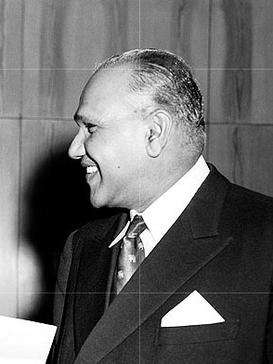Senerat Gunewardene
Sir Ratnakirti Senerat Serasinghe Gunewardene, KBE (3 November 1899 – 10 August 1981) was a Sri Lankan statesmen and diplomat. He was the Minister without Portfolio in the first post independence government and member of parliament, prior to which he had served as acting Minister of Local Government in the State Council of Ceylon. He later served as Ceylon's High Commissioner to United Kingdom, Ambassador to Italy and when he was serving as Ceylon's Ambassador to the United States he was appointed concurrently as the first Permanent Representative to United Nations.[1]
Rt. Hon. Sir Senerat Gunewardene | |
|---|---|
 | |
| Member of the Ceylon Parliament for Gampola | |
| In office 1947–1948 | |
| Preceded by | seat created |
| Succeeded by | R. S. Pelpola |
| Minister without Portfolio | |
| In office 26 September 1947 – 1948 | |
| Personal details | |
| Born | 3 September 1899 |
| Died | 10 August 1981 (aged 81) |
| Nationality | Sri Lankan |
| Alma mater | S. Thomas' College, Mount Lavinia |
| Occupation | Politics, Diplomat |
| Profession | Advocate |
Early life
Born in born on 3 November 1899 in Nupe, Matara as Samson Gunewardene, he later changed his name to Ratnakirthi Senerath Serasinghe Gunewardene. His father Don Bentis Serasinghe Gunewardene as an ayurvedic practitioner. Educated at S. Thomas' College, Mount Lavinia, he had to leave school before completing his final exams due to the death of his father. He then became a teacher at St. Thomas' College, Matara, before completing his London exams joining the teaching staff of Royal College Colombo. Thereafter he became the first principal of Sri Sumangala College, Panadura. He started studying law at the Ceylon Law College and was admitted as an Advocate in 1927. Starting his legal practice, he developed a successful practice in criminal defense and civil rights. He was also a founder member and President of the All-Ceylon Buddhist Congress.
Political career
Joining active politics in at the establishment of the Ceylon National Congress, in which Gunewardene was its Joint Secretary (1926–32) and later Vice President. During this time he campaigned for universal suffrage. In 1936 he was elected to the State Council of Ceylon from Gampola and served as acting Minister of Local Government in November 1936. Retaining his seat in the 1947 general election, he entered the first post independence parliament and was selected by D. S. Senanayake as Minister without portfolio in his first cabinet. Gunewardene was also the chief government whip during this time. He lost his seat in an election petition and although he contested the by-election, he failed to win.[2]
Diplomatic career
In 1949, he was appointed as Ceylon's Ambassador to Italy where he served until 1954 when he was appointed Ceylon's Ambassador to the United States. When Ceylon became a member of the United Nations in 1955, Gunewardene was appointed concurrently as the first Permanent Representative to United Nations, serving until 1958. He was reappointed as Permanent Representative to United Nations in 1963 serving until 1965. During his time in Washington DC, he established the Buddhist Centre in Washington.[2]
Honors
For his service to the government of Ceylon, he was made a Knight Commander of the British Empire.
Family
He married his wife Sumana Pemi Gunewardene on 10 June 1927, they had three children.
See also
- Sri Lankan Non Career Diplomats
References
- "Our Heritage". sundaytimes.lk.
- "Our Heritage 061022". sundaytimes.lk.